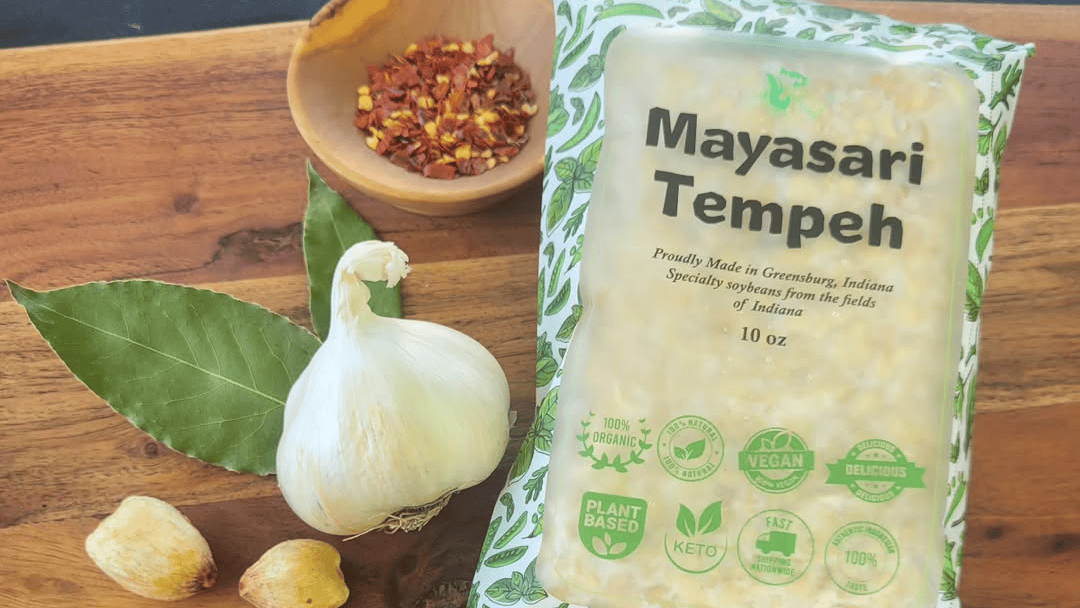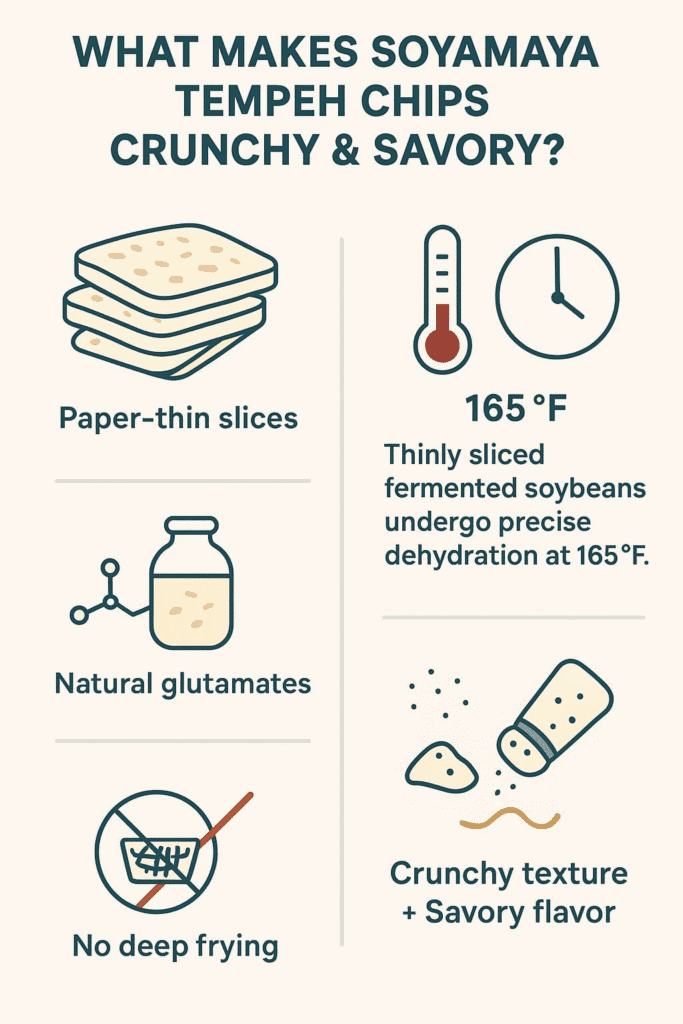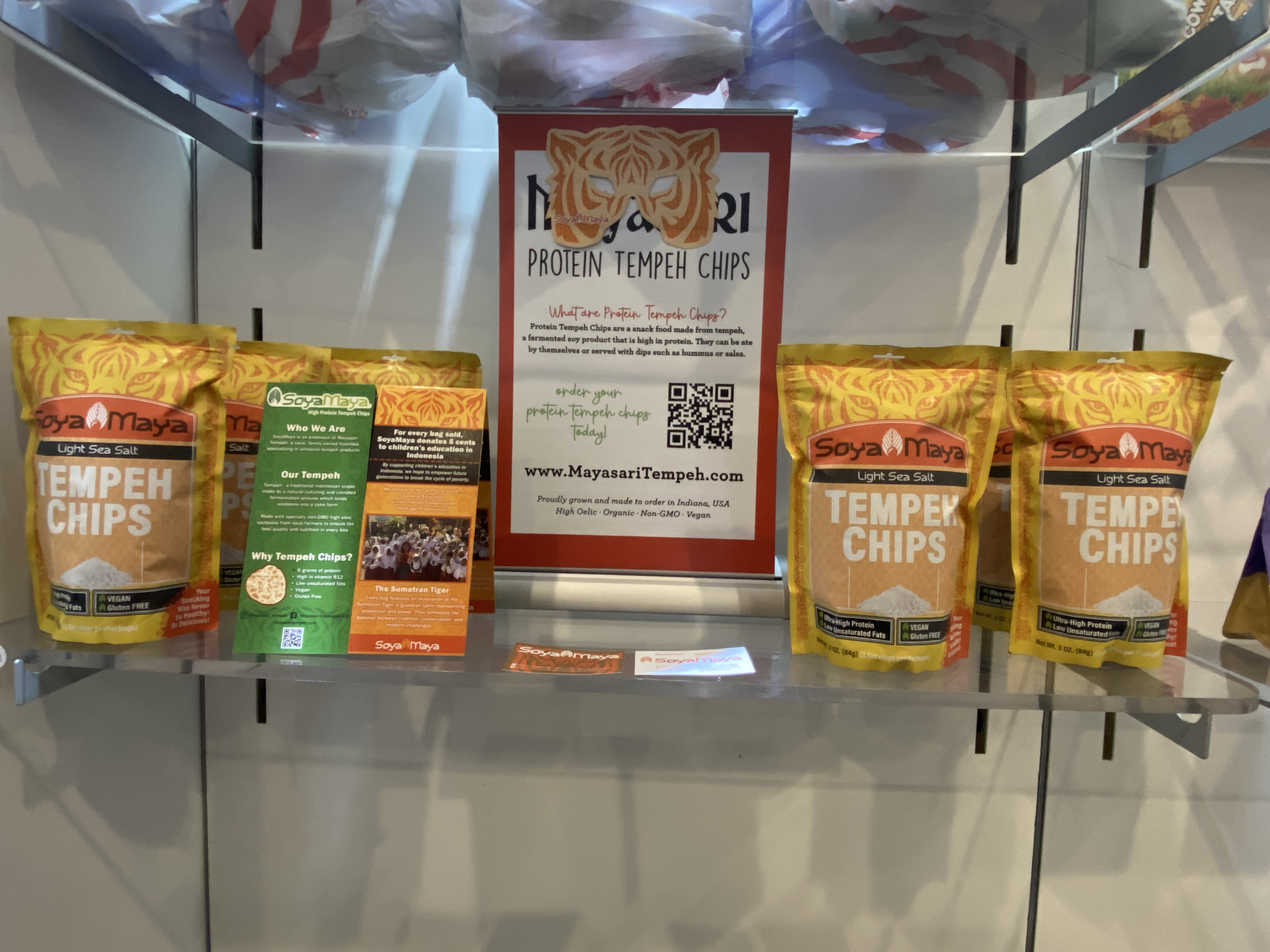What makes them crunchy and savory tempeh chips from Soya Maya. The crunch in Soya Maya’s tempeh chips comes from a pretty straightforward mix of science and old-school cooking. These chips, sliced paper-thin from blocks of fermented soybeans, go through a precise dehydration process at 165°F (that’s the sweet spot they found after months of testing).
The savory kick? That’s from natural glutamates developing during fermentation, plus a light dusting of sea salt and organic spices. Nothing fancy or artificial – just whole soybeans transformed into something that actually makes you forget you’re eating healthy. The company’s found a way to keep that satisfying crackle without deep-frying, which is probably why health food stores can’t keep them in stock.
Want to know what makes these different from your average bag of chips? Keep reading.
Key Takeaway
- Paper-thin slices and precise cooking temperatures give Soya Maya chips their satisfying crunch.
- The natural fermentation process brings out deep, savory notes – no need to pile on extra seasonings.
- They don’t mess around with cheap fillers or additives, just real tempeh done right.
Crunchiness Components of Soya Maya Tempeh Chips
Fermented Soybeans (Tempeh) as Primary Entity for Crunchiness
Inside a small factory in downtown Portland, something’s happening to soybeans that might change how you think about chips. Soya Maya’s got this whole process down to a science, and it starts with beans that don’t look like much at first glance. They slice these fermented soybeans paper-thin – we’re talking about 2-3 millimeters here.
It’s pretty basic stuff really, but there’s this special mold (they use something called Rhizopus oligosporus) that does the heavy lifting. The mold’s not gross or anything, it just makes the beans stick together better, which is exactly what you want when you’re trying to make a chip that doesn’t fall apart in your hand. The whole fermentation thing takes about 36 hours, and somehow that’s what gives these chips their signature snap.
Starch Additives Entity Enhancing Crunchiness
A pinch of tapioca starch’s all it takes to make things crunch. Anyone who’s messed around in the kitchen knows it soaks up water like nobody’s business, leaving a shell that stays crispy even after it cools down.
Sure, there’s cassava or sago that might do the job, but tapioca’s what works best – tried and true. It’s pretty neat that it doesn’t mess with people’s stomachs either (and works for the gluten-free crowd too). After all these test batches, nothing beats that satisfying snap when you bite into it.
Cooking Method Entity Influencing Crunchiness
Getting that perfect crunch isn’t rocket science, but it does take some know-how. The old standby, oven-baking at 375°F, gets chips crispy without drowning them in oil. Some people swear by deep-frying, and yeah, it works too (if you keep the oil at exactly 350°F and don’t let it drop).
The whole thing’s pretty straightforward – cook ‘e too long and they’ll turn into charcoal, but nail the timing and they’ll come out just right. Like most things in the kitchen, it’s all about watching and waiting. And maybe crossing your fingers a little bit.
Savory Flavor Elements of Soya Maya Tempeh Chips

Natural Umami Entity from Fermented Soybeans
The deep, earthy taste in these tempeh chips comes straight from soybeans doing their thing during fermentation (usually around 36-48 hours at 88°F). There’s this rich, almost meat-like flavor that just happens naturally – no fancy additives needed.
It’s got that same satisfying taste you might get from a good mushroom broth, and each batch gets checked pretty often to make sure it hits that sweet spot between too mild and too strong. Some batches turn out nuttier than others, that’s just how fermentation goes, but they’re all pretty darn good.
Seasoning Entity Enhancing Savory Taste
Salt works. Not the fancy stuff, just plain sea salt that sharpens the light flavor profile of tempeh and brings out what’s already there. Most cooks might go overboard trying to mask the natural taste, but a pinch here and there does the job.
Sure, throwing in some crushed garlic or ground coriander seeds adds something extra (when the mood strikes), but there’s no point in drowning out tempeh’s nutty, almost meat-like flavor. This stripped-down way of seasoning means you’ll taste what you’re supposed to taste – nothing fake, nothing forced, just good food doing its thing.
Ingredient Quality Entity Impacting Flavor Authenticity
SoyaMaya chips start with soybeans grown in fields just outside their main facility. Not the processed stuff, but actual soybeans plucked from family farms (most within 50 miles of production). These beans make all the difference – they’re organic, non-GMO, and each batch gets tested before making it into the chips. The result? A chip that’s got this earthy, nutty taste you just don’t get from the mass-produced junk.
No weird ingredients you can’t pronounce, no sneaky additives hiding in the fine print. Just beans, salt, and a few basic seasonings that your grandmother would recognize. Pretty straightforward stuff.
Production Process Attributes Affecting Crunchiness and Savory Profile
Slicing Technique Entity for Optimal Chip Thickness
The art of tempeh-slicing at Soya Maya brings a whole new meaning to precision. Generations of practice taught us that 2 millimeters isn’t just some random number – it’s where magic happens with these protein-packed blocks. Any amateur can cut tempeh, but getting that perfect slice? That’s something else entirely.
Most newcomers grab whatever knife’s closest and hack away, but that’s a fast track to wasted product. Our blocks need that Goldilocks treatment – not too thick or thin, just right. Some days the tempeh’s a bit softer than usual, and that’s when experience really counts.
Essential elements for the perfect slice:
- Block temperature: 40-45°F (straight from the cooler)
- Knife angle: 15 degrees
- Cutting speed: Slow and steady
- Block firmness: Should resist slight thumb pressure
Common issues we see:
- Crumbling edges from dull blades
- Uneven thickness
- Rushed cuts leading to diagonal slices
- Wrong temperature (too cold = brittle, too warm = mushy)
Tools that work best:
- Traditional wire cutter (expensive but worth it)
- 8-inch chef’s knife (our daily go-to)
- Ceramic blade (good but breaks easily)
- Electric slicer (for big batches only)
The old folks who’ve been doing this since forever might laugh at all these specifics, but there’s no arguing with results. A proper slice means better absorption, crispier edges, and that signature texture our customers can’t get enough of.
Seasoning Application Entity
Salt and spices don’t work without the clock ticking right beside them. Anyone might think tossing seasonings at random’s good enough – it’s not. They’ve got to hit the food when it’s ready, when the pores are open and hungry. Kind of like your skin after a hot shower (that’s what the food science folks say anyway).
You need salt that spreads out nice and even, no clumps, no missed spots. Nothing worse than taking a bite that’s bland next to one that’s way too salty. Every mouthful’s got to taste the same, whether it’s the first or last piece on the plate.
Cooking Control Entity

Temperature matters, there’s no question about it. You can see the difference between good and awful food just by watching the heat – a steady 350°F works better than wild swings between 300°F and 400°F. Nobody wants burnt edges with a raw middle. Time’s pretty straightforward too, they keep the food in until it turns golden brown (usually around 12-15 minutes for most stuff).
And yeah, they don’t just dump oil everywhere – they use just enough to get that nice crunch. Makes sense, since nobody wants to eat a grease bomb. The food comes out pretty good this way, crispy but not swimming in oil.
Nutritional and Consumer Value of Soya Maya Tempeh Chips
Digestive Health Entity from Fermented Ingredients
Watching tempeh ferment might not sound like everyone’s idea of fun, but there’s something fascinating about how these beans transform into crunchy snacks. The natural bubbling and aging process doesn’t just make these chips taste better – it turns them into something your stomach will thank you for.
These chips pack a decent amount of good bacteria (about 1 billion CFUs per serving), and since they don’t have any gluten, pretty much anyone can munch on them without worry. It’s no wonder people keep asking where to buy these sea salt tempeh snacks when shelves run empty so fast.
Maybe it’s the 48-hour fermentation time, or the way the soybeans break down, but there’s definitely more going on here than in your average bag of potato chips (1).
Clean-Label Ingredient Entity Supporting Consumer Trust
The back of our snack bags won’t make your head spin with a chemistry textbook list. Just six natural ingredients you’d find in most kitchen pantries – the kind you can actually pronounce. No weird stuff, no hidden extras, and definitely no ingredients that sound like they belong in a lab. That’s the whole story. Simply good food that doesn’t need fancy tricks to taste amazing.
Sensory Experience Value Providing Crunchy and Savory Satisfaction
These tempeh chips snap between your teeth with a clean break – no oily residue, no strange aftertaste. Just that earthy, almost mushroom-like punch that hits the tongue right away, followed by just enough salt to make you reach for another handful. The kind of snack that doesn’t feel like a compromise, perfect for midnight movie watching or afternoon desk grazing.
Additional Considerations for Enhancing Soya Maya Tempeh Chips’ Appeal
Storage and Packaging Entity Maintaining Crunchiness
Soya Maya’s storage crew knows chips aren’t meant to be soft. Ever. Their obsession with keeping each batch perfectly crunchy might seem excessive, until you’ve tried a stale tempeh chip – then you get it. The team’s got this down to a science, packing each batch in those multi-layer bags that don’t let moisture sneak in.
The packaging lab’s got standards that’d make most food companies sweat. Every bag needs to pass their crunch test, which means random samples get checked weekly. Sometimes daily, if the weather’s acting up. Just ask the QC team – they’ve probably rejected more bags than most people will see in their lifetime.
Here’s what makes their storage system work:
- Triple-sealed bags with moisture barriers
- Temperature-controlled warehouse (kept at 68°F)
- 45-day freshness window
- Stackable boxes that prevent crushing
- Weekly crunch tests on random samples
- Humidity monitors in storage areas
The night shift supervisor mentioned they once tossed an entire day’s production because the seals were off by half a millimeter. That’s just how they roll at Soya Maya. No compromises, even when nobody’s looking. The chips stay fresh for weeks, though most folks can’t keep a bag around that long.
Flavor Variation Entity Expanding Product Range

The old standbys rake in cash, but taste buds get bored. Fresh herbs from the greenhouse, mixed with dried spices that pack a punch – that’s where things might get interesting. They’d give people something new to munch on (imagine what you could pair with sea salt chips, like nuts or dried fruits), all while keeping that satisfying crackle when you bite down. Not rocket science, just good old-fashioned flavor mixing that doesn’t mess with what already works.
Sustainable Production Entity Supporting Brand Values
Right down the street from their production facility, rows of soybeans stretch across local farms. SoyaMaya makes their protein products from these beans, cutting down shipping miles and keeping money close to home. They’re not perfect – but they’ve figured out some smart ways to deal with leftover materials from production.
The company partners with 12 farms within a 50-mile radius, buying about 40,000 pounds of soybeans yearly. Any waste gets composted or turned into animal feed. Feels like they mean what they say about helping both the earth and their neighbors.
FAQ
What makes tempeh snack different from other soy protein chips or healthy chips alternatives?
These days, you’ll find tempeh snacks sitting next to bags of trendy protein chips, but there’s something different about them. They’re born from fermented soybeans (a process that’s been around for centuries), and you can taste it. While other healthy alternatives throw in protein powder and whatever else to hold together, tempeh just does its thing naturally.
The fermentation creates this nutty, almost mushroom-like flavor that you just don’t get from regular soy chips. Sure, there’s plenty of crunchy snacks out there, but Indonesian tempeh chips carry generations of know-how in each bite. The small-batch stuff, made from non-GMO soybeans, really shows off what traditional methods can do.
How does traditional tempeh make vegan savory snacks with nutty flavor tempeh?
The old-school way of making tempeh isn’t fancy – it’s just whole soybeans doing their thing with some culture that turns them into a solid cake. Slice it thin, cook it right, and you’ve got yourself these incredibly satisfying vegan bites (2).
The beans stay whole through the process, which means you’re getting all that protein packed into each crunch. Indonesian makers have been doing this forever, and it shows. No rushing, no shortcuts. Just patience and knowledge passed down, creating chips that taste like they’ve got a story to tell.
Why do fermented soybean chips and small-batch soy crisps carry a complex nutty taste?
Time’s the secret here – we’re talking about two whole days of fermentation that builds layers of flavor you can’t fake. These aren’t your mass-produced snacks; they’re often made with soybeans from farms where people still care about doing things right.
Small batches mean somebody’s paying attention, making sure each batch develops that deep, nutty flavor that makes you want to reach for another handful. The slow fermentation doesn’t just make them taste good – it’s actually doing something good, breaking down the beans in ways that make them easier to digest.
What makes farm-to-snack chips or artisanal food products a healthy crunchy munch choice?
The beans in these snacks often come from farms just down the road, not some massive operation halfway across the world. They’re turning simple soybeans into something pretty special – light, crispy, and actually filling. Some makers add just a touch of sea salt, nothing crazy. Whether you’re picking up a bag labeled vegan, plant-based, or artisanal, you’re getting something that’s been thought through.
These aren’t just empty calories like regular chips – there’s actual nutrition behind the crunch. And yeah, they might cost a bit more, but that’s what happens when people take the time to do things right.
Conclusion
In a world of processed snacks and artificial flavors, SoyaMaya’s tempeh chips stand apart. These aren’t your average potato chips – they’re a crunchy, savory revelation made from Indiana-grown soybeans (and yeah, they’re actually good for you).
Each batch is carefully fermented using traditional methods that’ve been around for generations, giving them that authentic nutty taste that’s kind of addictive. They’ve packed these chips with protein and B12, which you don’t find in most plant-based snacks.
Ready to try something different? Grab a bag of these tempeh chips and see what real Indonesian-inspired snacking tastes like.
References
- https://www.grandviewresearch.com/industry-analysis/tempeh-market-report
- https://smallbatchdistributor.com/index.php?product_id

